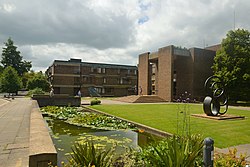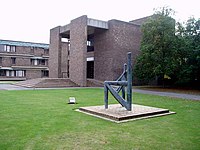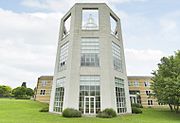Churchill College, Cambridge
| Churchill College
| |||||||||||||||||||
|
Forward | |||||||||||||||||||
|---|---|---|---|---|---|---|---|---|---|---|---|---|---|---|---|---|---|---|---|
 Entrance to Churchill College in June 2019 | |||||||||||||||||||
 | |||||||||||||||||||
| Master: | Dame Athene Donald | ||||||||||||||||||
| Website: | chu.cam.ac.uk | ||||||||||||||||||
| |||||||||||||||||||
| Location | |||||||||||||||||||
| Grid reference: | TL43725923 | ||||||||||||||||||
| Location: | 52°12’45"N, -0°6’8"E | ||||||||||||||||||
Churchill College is a constituent college of the University of Cambridge[1] in Cambridge, England. It has a primary focus on science, engineering and technology, but retains a strong interest in the arts and humanities.


In 1958, a trust was established with Sir Winston Churchill as its chairman of trustees, to build and endow a college for 60 fellows and 540 students as a national and Commonwealth memorial to Winston Churchill; its Royal Charter and Statutes were approved by the Queen Elizabeth II, in August 1960.
The college stands on the outskirts of Cambridge, away from the traditional centre of the city, but close to the University's main new development zone (which now houses the Centre for Mathematical Sciences). It has 40 acres of grounds – the largest area of the Cambridge colleges.
Churchill was the first formerly all-male college to decide to admit women, and was among three men's colleges to admit its first women students in 1972.[2] Within 15 years all others had followed suit. The college has a reputation for relative informality compared with other Cambridge colleges, and traditionally admits a larger proportion of its undergraduates from state schools.
The college motto is "Forward", which was taken from the final phrase of Winston Churchill's first speech to the House of Commons as Prime Minister of the United Kingdom, known as the "blood, toil, tears and sweat" speech in which Churchill said, "Come, then, let us go forward together".[3]
History
In 1955, on holiday in Sicily soon after his resignation as prime minister, Winston Churchill discussed with Sir John Colville and Lord Cherwell the possibility of founding a new institution. Churchill had been impressed by the United States' Massachusetts Institute of Technology and wanted a British version, but the plans evolved into the more modest proposal of creating a science and technology-based college within the University of Cambridge.[4] Churchill wanted a mix of non-scientists to ensure a well-rounded education and environment for scholars and fellows. The college therefore admits students to read all subjects except land economy and theology and religious studies (though it is possible to switch to these subjects later).
The first postgraduate students arrived in October 1960, and the first undergraduates a year later. Full college status was received in 1966.
Initially all students were male. Women were accepted as undergraduates in 1972, one of the first three previously all-male colleges to do so.[5]
The bias towards science and engineering remains as policy to the current day, with the statutes requiring approximately 70% science and technology students amongst its student intake each year.[6] The college statutes also stipulate that one third of the students of the college should be studying for postgraduate qualification.
Buildings and grounds
In 1958, a 42-acre site was purchased to the west of the city centre, which had previously been farmland. After a competition, Richard Sheppard was appointed to design the new college. Building was completed by 1968 with nine main residential courts, separate graduate flats and a central building consisting of the dining hall, buttery, combination rooms and offices.
The dining hall is the largest in Cambridge. It measures 72 feet square, 30 feet to the base of the vault beams, and 38 feet to the highest point. It can cater for up to 430 guests in a formal dining arrangement.
The main college buildings and courtyards are arranged around a large central space, in which the library was placed. Only a few years later, being opened in 1974, an extension to the library building was added to house the Churchill Archives Centre. Its original purpose was to provide a home to Sir Winston's papers, however since then it has been endowed with papers from other political figures including former Prime Ministers Margaret Thatcher and John Major, as well as former Leader of the Opposition Neil Kinnock, and those of eminent scientists and engineers including Reginald Victor Jones, Rosalind Franklin and Sir Frank Whittle.[7]

In 1992, the Møller Centre for Continuing Education was built on the Churchill site, designed by Henning Larsen. It is a dedicated residential executive training and conference centre, aiming to bring together education and commerce.[8]
As well as the main College buildings, Sheppard designed a separate group of flats, known as the Sheppard flats, for the use of married graduate students. These are located to one side of the College grounds, a short distance from the main buildings. The college's central buildings and chapel are Grade II listed.[9][10]
Chapel
At the farthest end of the college grounds is the chapel. Sheppard's original design placed it within the main building complex near the college main entrance.[11] The idea of having a religious building within a modern, scientifically-oriented academic institution deeply annoyed some of the original fellows, leading to the resignation of Nobel Prize winner Francis Crick in protest.[12] Eventually a compromise was found: the chapel was sited just to the west of the Sheppard Flats,[13] and funded and managed separately from the rest of the College itself, being tactfully referred to as "the Chapel at Churchill College". The chimney of the heating system at the front of the college substitutes visually for the missing chapel tower.
Crick had agreed to become a fellow on the basis that no chapel be placed at Churchill. A donation was later made by Lord Beaumont of Whitley to Churchill College for the establishment of one, and the majority of fellows voted in favour of it. Sir Winston Churchill wrote to him saying that no-one need enter the chapel unless they wished to do so, and therefore it did not need to be a problem.
Outside links
| ("Wikimedia Commons" has material about Churchill College, Cambridge) |
References
- ↑ Walker, Timea (2022-08-04). "Churchill College" (in en). https://www.undergraduate.study.cam.ac.uk/colleges/churchill-college.
- ↑ "Dick Tizard" (in en). 2005-10-09. https://www.independent.co.uk/news/obituaries/dick-tizard-318358.html.
- ↑ "Churchill College Hospitality - About Churchill College". http://www.churchillconferences.co.uk/college.htm.
- ↑ Walsh, James Jackson (1998). "Postgraduate Technological Education in Britain: Events Leading to the Establishment of Churchill College, Cambridge, 1950-1958". Minerva 36 (2): 147–177. doi:10.1023/A:1004396018945.
- ↑ "Five decades after Cambridge colleges went co-ed, too little has changed". Financial Times. 2022-08-31. https://www.ft.com/content/db52b02b-088f-4bfc-8e66-ce7dda0267fc.
- ↑ "Churchill College Statutes (PDF)". 1 January 2010. http://www.chu.cam.ac.uk/about/official/statutes_and_ordinances/statutes.pdf.
- ↑ "Churchill Archive Centre". http://www.chu.cam.ac.uk/archives/.
- ↑ "The Møller Centre". http://www.mollercentre.co.uk.
- ↑ National Heritage List 1331925: Chapel, Churchill College (Grade II listing)
- ↑ National Heritage List 1227706: Central Buildings Churchill College (Grade II listing)
- ↑ Goldie, M.; Corbusier Comes to Cambridge, Churchill (2007).
- ↑ "The Francis Crick Papers: Biographical Information". http://profiles.nlm.nih.gov/SC/Views/Exhibit/narrative/biographical.html.
- ↑ "Churchill College: Information: Map of College". http://www.chu.cam.ac.uk/about/visitors/map_of_college.php.
| Colleges of the University of Cambridge | |
|---|---|
|
Christ’s • Churchill • Clare • Clare Hall • Corpus Christi • Darwin • Downing • Emmanuel • Fitzwilliam • Girton • Gonville and Caius • Homerton • Hughes Hall • Jesus • King’s • Lucy Cavendish • Magdalene • Murray Edwards • Newnham • Pembroke • Peterhouse • Queens’ • Robinson • St Catharine’s • St Edmund’s • St John’s • Selwyn • Sidney Sussex • Trinity • Trinity Hall • Wolfson |
 |
